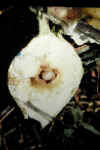| 8-25-08
With Labor Day closing in, we reluctantly bid summer adieu, but not
without sampling its many wares after a session on the range with our feet
planted squarely under the dinner table. With it comes many joys of preparing
an consuming the many items nature has given us.
Two of the best products of nature are the nuts produced each year (this
year they are somewhat spotty, but still available in many areas of the
state). Finding them is a matter of scouting--or merely being observant.
At any rate, hickory nuts and black walnuts are staples for squirrels.
Humans could take a page from Mr. Bushytail’s book for some real healthy
snacking and cooking.
Hickory nuts, most important of the two, comes in many sizes (from shellbarks--those
little, sweet-meated, thin-shelled dudes--to the larger river bottom nuts,
with harder shells and coarser, nuttier-tasting meats). They are all Mother
Nature’s gift to a people who scarcely know them.
Walnuts are equally tasty and are used by some for snacking and cooking
in many dishes from salads to pies and other forms of baking. Their chief
drawback, of course, being that to harvest and use them one must subject
the hands to stains of the outer husk. Only time wears away the stain.
The former (hickory nuts) also have an outer hull, but it is divided
into quarters (sometimes fifths) and the hard inner nut can easily be shucked
from the outer husk (some nuts may require a knife blade). Still, removal
of the outer, juicy hull of walnuts is almost as easy. Just get comfortable
before a container of the nuts and hit each one with a solid object to
flatten the husk, then flick out the hard inner nut to dry in the fall
sun. Dry the walnuts in a matter that will thwart squirrel’s efforts to
filch them. Hickory nuts are not dried in the sun because this causes them
to check (develop cracks).
One of the great features of this outdoor activity lies in the fact
that it is all free, and requires little expenditure for equipment. All
one needs is buckets to hold the nuts, a hard surface on which the walnuts
are placed for hulling, and a hard object to strike them. For hickory nuts,
the shelling procedure is even more simple . . . and less messy.
I fashion walnut shelling paddles from one-foot long boards (can be
longer if desired) that are thick enough to have some heft. I make a handle
on one end with a hatchet, then rasp the handle smooth. Walnut hulling
paddles rate right along with mushroom sticks.
Walnut leaves and the leaves of early maturing hickories are starting
to fall of their own volition now. This indicates nuts are mature. Still,
they must be dried to offer tasty goodness.
One precaution I take involves carrying Vise-Grip pliers in my pickup
to “crack” nuts to verify their worth before I collect them. If I find
a hickory tree that produces wormy nuts, I save them for fish bait. The
little white grubs in walnut hulls also are good fish bait, but saving
them inolves stain and their minuteness makes them difficult to put on
a hook. Galls in goldenrod also provide good fish bait. Refrigeration keeps
them from pupating until ice fishing arrives.
FALL SQUIRRELS -- As September
arrives, dryness in the woods often prohibits a great amount movement and
creates ideal conditions for a sedentary hunt. Just find an area where
squirrel activity is obvious (there are many signs) and have a seat in
the forest. Soon you will find squirrels, or, more accurately, they will
find you.
I like a wooded hillside near a creek or pond (water is always a drawing
card for game at this time of year).
Squirrels often cut (feed) early and late in the day, but snooze (flattened
out on big tree limbs) through the warmer hours. They may also use the
middle of the day for burying food for winter in the ground. Fox and gray
squirrels place one morsel of food at each dig. Pineys cache food supplies.
Fall, and the propensity for low shots at squirrels, brings stronger
chances of hitting other hunters. So know what your shot may hit in case
you miss the game. Shotguns are safer than rifles for low shots.
Standing field corn or corn stubble, adjacent to woodlands, are both
big drawing cards for squirrels.
Click on thumbnail image for enlarged view.

|

|

|
| Hickory nut
worms emerge from nut. |
Goldenrod
gall
|
Cracking
hickory nuts provides great food.
|
|

